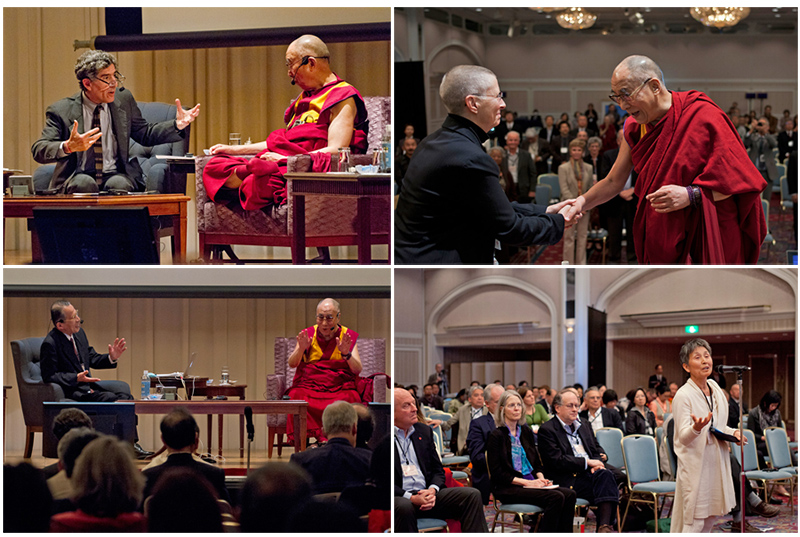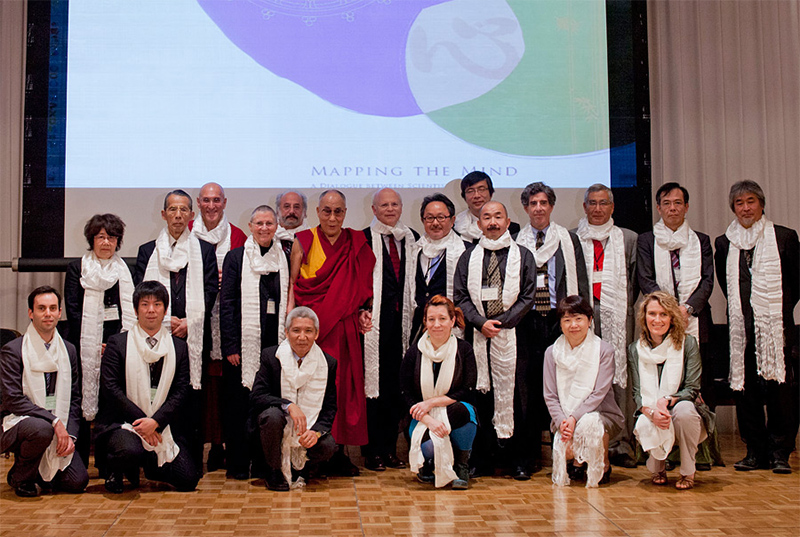 Kyoto, Japan 11 April 2014 - A two day dialogue focused on the theme 'Mapping the Mind' was opened by His Holiness the Dalai Lama who explained that this was about taking on the whole system of mind and emotions.
Kyoto, Japan 11 April 2014 - A two day dialogue focused on the theme 'Mapping the Mind' was opened by His Holiness the Dalai Lama who explained that this was about taking on the whole system of mind and emotions.
He opened proceedings by saying, "Mind & Life meetings have been happening for more than 25 years, but I have been keen that they should also be held in an Asian country where Buddhist ideas are historically part of the culture. In our discussions with scientists about mind, much of the understanding of the mind comes from ancient India.
My own understanding is based on the Buddhist science of mind. This is not to say we have ever talked about past and future lives, liberation or emptiness, those are topics that are properly the business of Buddhists. We have confined ourselves to discussions of the mind, brain and so forth, which is why I think we can refer to conversations between Buddhist science and modern science."
He suggested that Buddhists may be more receptive to ideas that derive from ancient Indian psychology, related to the practice of concentration and insight. Mapping the mind is about taking a wider perspective and coming to know about the whole system of mind and emotions, which helps us come to terms with the problems we share.
Yoshio Imaeda, a Japanese scholar of Buddhism began the presentations by recalling his surprise at finding that his father had no idea what he was reciting in front of his Buddhist altar. By conducting his own research he discovered that not only do Tibetans have the most exhaustive collection of Mahayana texts, but that Tibetan Buddhism remains a living tradition, despite the tragedy that has taken place in Tibet. He described Japanese monks as professionals, particularly with regard to funeral arrangements, and Japanese Buddhists as emotional and sentimental, but not rational.
His Holiness laughed, saying: "This seems like a session of self-criticism." Then he explained that of 6 million Tibetans 99% don't have much idea of what Buddhism is really about either. "To be Buddhists in the 21st century we have to study," he said, remarking that over the last 40 years nuns as well as monks had been able to take the highest degrees.
Arthur Zajonc asked which comes first, practice or study. His Holiness referred to the three modes of understanding. First listening, reading and study lead to belief and conception. Critical reflection leads to conviction and deep familiarity with that leads to real understanding.
Under the theme 'Change your brain by changing your mind' Richard Davidson spoke about the findings of neuroplasticity, in which changing the mind can be shown to affect the brain. When Davidson referred to work that is being done with children with attention deficit hyperactive disorder (ADHD) His Holiness wanted to know if it seemed to be a result of environmental or genetic influences and whether there was any association with anxiety and feelings of insecurity.
 Dr Davidson reported that even short term compassion training, in which subjects spend 30 minutes a day over two weeks training in compassion can be shown to have positive effects on the brain. Finally, acknowledging the time that young people spend playing computer games, he reported a pilot project to develop such games that foster kindness and empathy rather than aggression.
Dr Davidson reported that even short term compassion training, in which subjects spend 30 minutes a day over two weeks training in compassion can be shown to have positive effects on the brain. Finally, acknowledging the time that young people spend playing computer games, he reported a pilot project to develop such games that foster kindness and empathy rather than aggression.
His Holiness responded that it is useful to just let the mind settle in thoughtlessness for some time to begin to be aware of its nature and that it is possible to develop an ability to examine the mind, for example when we want to observe anger.
In his presentation about the role of mind in quantum physics, Arthur Zajonc surprised His Holiness with his description of a particle with no size. He asked what is going on when, unable to find a solution to a problem, suddenly unbidden one appears to the mind. His Holiness suggested it is connected to the work already done and mentioned that a problem that can't be solved during the day may be solved in dream time. He said that perhaps it is because in dream time sensory consciousnesses are inactive.
Arthur Zajonc took the opportunity to extol the power of thought, its clarity and accuracy. He pointed out that Einstein's theory of relativity did not come about as a result of work or experiments in the laboratory. He reached his conclusions due to the power of thought.


![Tibet has a rich history as a sovereign nation until the 1950s when it was invaded by China. [Photo: File]](/images/stories/Pics-2024/March/Tibet-Nation-1940s.jpg#joomlaImage://local-images/stories/Pics-2024/March/Tibet-Nation-1940s.jpg?width=1489&height=878)















